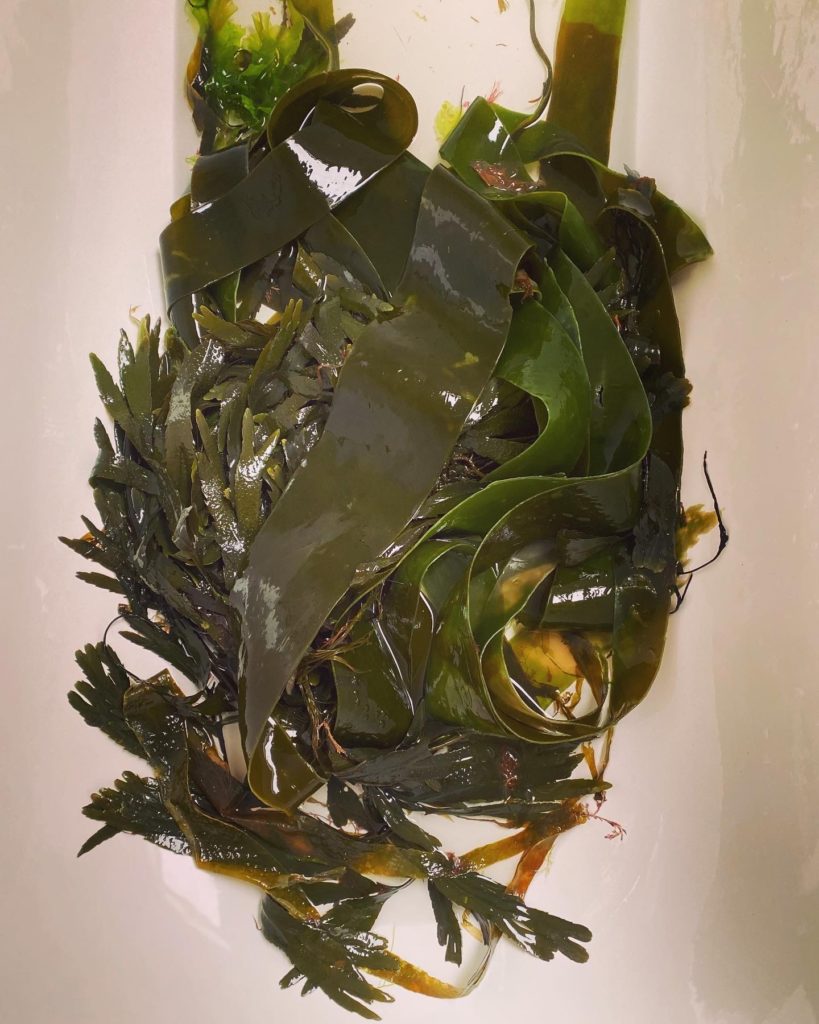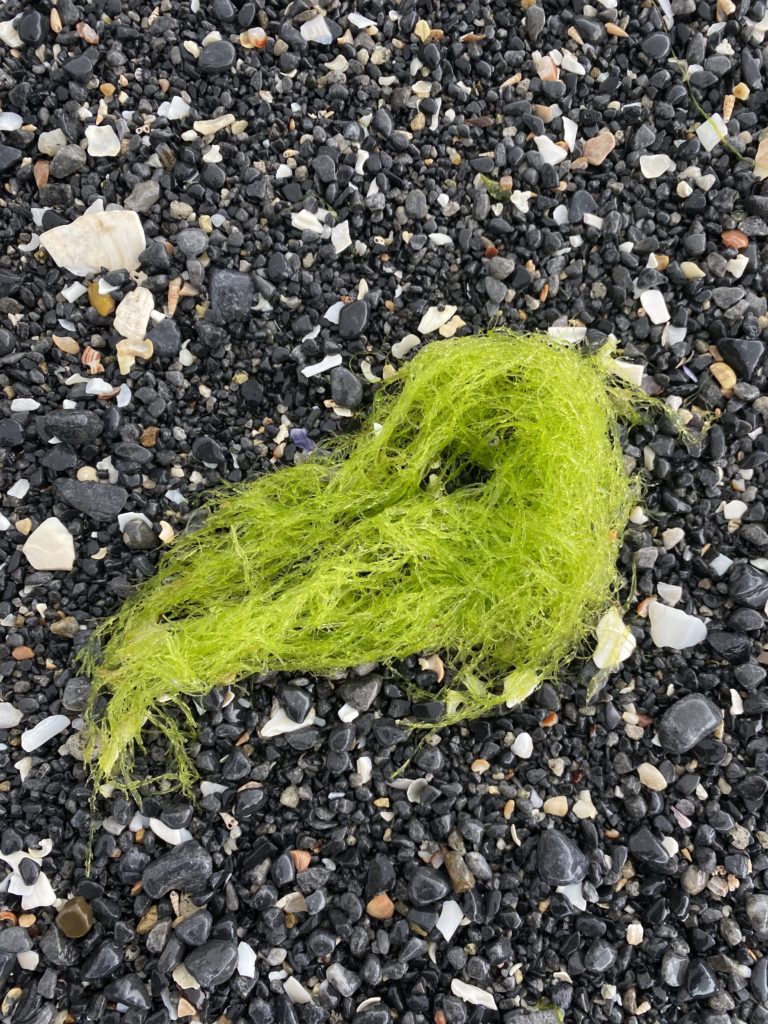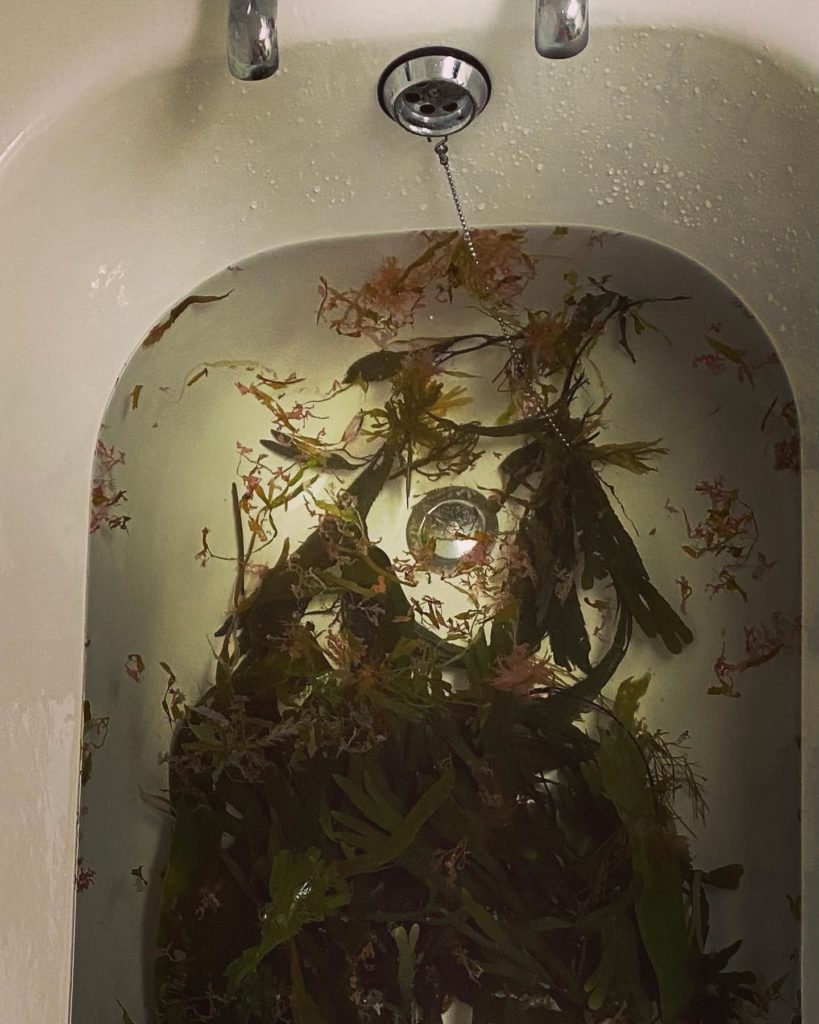From vital sustenance to the production of iodine, Róisín Á Costello considers the Irish historical importance of seaweed.

It is a grey morning and rain is puckering the flat expanse of the Irish sea. If the sun were out, I would be able to see the rainbow lick of engine oil on the water’s surface, drifting south from the harbour, but it is overcast so the water is a dull pewter. Seaweed tangles in my fingers as I swim. I count the types. A bright ochre scrap of ríseach (thong weed). A dendritic, veined frill of something scarlet I do not recognise. Brown-black snaggles of bladderwrack, tooth wrack. Cycling to work the next morning along the River Liffey, a low tide has exposed the matted carpet of brown seaweeds that clings to the river bed and the granite foot of the quays that contain it. The shorelines surrounding Ireland and Britain are home to roughly 6% of the world’s seaweed species and there are over five hundred species found in Irish waters. Most are wracks like these, hardy and pollution resistant, thriving in intertidal areas. Across the country from Dublin, however, the species multiply. A single reef on the Atlantic coast in Finavarra, County Clare is home to 336 species — the greatest diversity of seaweeds in any one place on these islands.
Historic records of the communities along the Atlantic coast of Ireland depict a people whose survival was built around seaweed until well into the twentieth century. Interviews recorded in the national folklore archive recount annual pilgrimages to collect seaweed in Spring, the men using long poles topped with hooks to drag clumps on board their currachs, the women loading the catch into wicker creels and spreading it out on land to dry. Seaweed was fed to humans, horses and cattle, applied to open wounds to stop infection, used to dye wool, and ground up and added to hot water to cure colds and coughs. Much of this material, recounting activities and practices still underway in the 1930s, exposes a world where land and sea could not be separated, success in one interwoven with survival in the other. In places, darker memories flit through the text. An eighty-five-year-old woman recalls that as a child in the 1850s her family lived on potatoes and boiled dúlamán (channel wrack) but that before she was born, they had lived on dúlamán alone. Along the Atlantic coast voices caught by the net of history repeat similar stories.
The Atlantic coast of Ireland was home to the areas affected most during the Famine of 1845-1849. Near Finvarra in County Clare, the parish of Gleninagh lost roughly 140 of its 200 inhabitants. The area never recovered. Today it is home to under 100 people. Similar patterns radiated along the Atlantic coast. One eyewitness travelling through the country in 1846 recorded that those who remained appeared to be surviving on the seaweeds and shellfish which could be found along the tideline. In his diary, he recorded that the rocks everywhere he stopped from Cork to Mayo were ‘picked clean.’ Maybe because of this role it played in sustaining those who survived, in the decades following the Famine as the number of Irish speakers began a steady decline, the words dúlamán, carraigín (carrageen) and creathnach (dulse) remained in common use in Atlantic communities — relics of an old order slung into otherwise English sentences. A vocabulary of survival.
The parish of Gleninagh was Irish speaking for another century after the end of the famine. In fact, the ring of communities that circled Galway bay north from Gleninagh, past Finvarra, and into Connemara and the Aran islands was, just over a century ago, a place hostile to English understanding. When the playwright and essayist JM Synge travelled to the Aran islands between 1898 and 1901 he was regarded as a half barbarian by the standards of these places. With only English and French he came to this coast to learn the kind of Irish that could not be gleaned from books. He spent portions of the summers harvesting ceilp (kelp) alongside the islanders for use in the production of iodine and watching how they mixed seaweed with sand, ashes, and animal manure to create the soil otherwise absent from the bare limestone landscapes they inhabited.

Today the beaches around Gleninagh are blanketed with seaweeds. To the south, my parents’ house faces the Aran islands, separated by a few miles of ocean and a wide field bisected by a diagonal track of beaten grass that leads from a red-painted gate to the water. The field, or maybe the track, is called ‘an geata rua’ (the red gate). It has been called this since before the most recent gate was painted red, though the endurance of the name suggests the gate has been red almost as long as there has been a gate. The track is a customary right of way that allows locals to cross the land to gather seaweed. A decade or so ago the current farmer took to putting a lock on the gate, which at least one other farmer routinely cuts — a demonstration against any attempt to rewrite the history of the path or to claim its use had been extinguished.
On an evening in May, I find the lock intact and climb over the gate with my mother, taking the path across the field. To the north, thick carpets of dúlamán swell out of the sand and into the sea. A testament to a well-fed population. Further north is Finvarra and its reef. To the South, the Aran islands are blue shadows sitting low in the water. The seaweeds that are harvested here now are mostly from the second category — not dúlamán but feamainn, which rhymes with famine when said aloud and includes within its blanket reference most kinds of seaweed that are not dúlamán, though the line between the two is hard to draw in my mind. My mother wants ceilp for the garden, and I am about to test the old remedy repeated in her family that, steeped in hot water, feamainn will cure the raised, red eczema that has started creeping from my fingers up my arms over the last six months, gaining momentum as I lose sleep and ground to deadlines.

It will be a full moon tonight, and the tide is high as dusk edges in. Mum pulls huge, leathery ribbons of ceilp from the tangle the tide has pushed up on the flat rocks. It looks like metre-long tagliatelle, mahogany brown and glistening. The sea is always choked with it here, the tides rush a soupy mix of species through the narrow spaces between a group of boulders and into a shallow pool that forms over a lip of limestone. I stand on the edge of the pool, plunging my hands into the glass-cold water, aiming for the feathery flaps of wrack that wave from the swirl of black and brown. The dark eddies are shot through with ribbons of gold ríseach, scraps of acid green sea lettuce, red and hot pink carraigín and dulse. My rings flash and then disappear in the swirl of colours as my hands sink into the pool and cold closes around my forearms, the water dragging my fingers off course, my search pulsing with the tide. The only sounds are the sigh of water and the screech of gulls. I remember a phrase collected by a friend from an old fisherman further south, ‘uaigneas an chladaigh’ — the loneliness of the seashore, the haunted feeling of the tideline, the harvest place, at dusk.
***
I wonder, watching bright white water fall into the bath, whether the seaweed has lost something in the hundred metres I have carried it. In the pool, it looked like it might wrap itself around my wrists and pull me into some dark space beneath the water. But now it just drifts gently from one side of the tub to the other, filling the room with a strong, brown smell. I sink beneath the serrated edges of the toothed wrack and the sinuous, reptilian kelp until only my head and knees are over the water. And wait. Soon the water begins to feel viscous, I lift one arm, and wriggling, snotty lines drip from my skin. The seaweed has thickened the water into a sort of gel. I think of Synge, on a Dublin operating theatre as a surgeon tried to halt the lymphoma that would kill him at 37, his skin stained with iodine made from kelp he might have helped to harvest a handful of kilometres away. I think of my great grandmother wrapping seaweed around sun blistered necks and hands worn bloody from baling hay, unwittingly drawing on the same power as a Dublin surgeon.

Shortly after Synge died, kelp harvesting ceased being a viable industry. Gradually, young people began to leave this coast and the language and customs Synge had travelled to learn retreated to the very margins of the Atlantic. In some places, like Gleninagh, they died off completely — became discoverable only in books. I wonder what was lost in the decades before Synge. What after. I watch the strange emulsified bathwater drip slowly from my fingertips. My skin in white beneath the water, the red retreating back down to my fingers for the first time in months. I think of my mother, who has lost her family’s language but managed to retain this secret, half-remembered cure — and the right to walk across a field to collect it. From downstairs I hear her turn on the radio. An old working song from County Donegal is playing. In it, two men argue over whether one can marry the daughter of the other — and whether she will have him. The would-be groom has come from abroad and though he is blunt-eared and coarse, he can buy fine gifts for his would-be bride. The girl’s fair-haired father resists the match but seems, in the end, to lose her to the blunt-eared upstart. The two protagonists, whose exchange forms the song are called dúlamán gaelach (Irish dúlamán — the seaweed used to dye cloth) and dúlamán maorach (edible dúlamán — the seaweed harvested to be eaten). There is a long running debate about the meaning of the song — whether the two men depicted represent native and foreign languages, the forces of tradition and progress, or simply the groups who would have worked the shoreline harvesting the two types of seaweed and sung in call and response to each other as they went. In any interpretation, the insistent beat of the song carries the history of this crop and this coast up through the ceiling of the kitchen and into the salt-steamed bathroom. Seaweed as medicine and commodity, food and fodder, earth-builder. A reminder of what has been lost and what can still be harvested.
*
Róisín Á Costello is a bilingual writer and academic who lives and works between Dublin and County Clare, Ireland. Her writing has been published in Elsewhere and The Hopper, and in the Spring 2022 issue of Banshee. Róisín has previously been shortlisted for the Bodley Head/Financial Times essay competition and in 2021 was selected as the recipient of a Words Ireland mentorship by Dublin City Council.